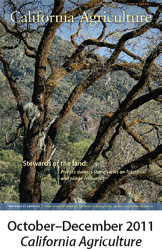All Issues
Letters
Publication Information
California Agriculture 66(1):5-5.
Published online January 01, 2012
PDF | Citation | Permissions
Full text
RSVP
WHAT DO YOU THINK?
The editorial staff of California Agriculture welcomes your letters, comments and suggestions. Please write to us at: 1301 S. 46th St., Building 478-MC 3580, Richmond, CA 94804, or calag@ucdavis.edu. Include your full name and address. Letters may be edited for space and clarity.
Research on forest clear-cutting
Regarding “Forest and rangeland owners value land for natural amenities and as financial investment” by Ferranto et al. (October–December 2011): Have the authors considered doing a survey of how Californians feel about the clear-cutting that is occurring throughout the state's private forest lands? The cumulative effects on water, soil, air and quality of life for Californians are not being discussed enough by the people who will be affected by the loss of these forests, which are owned by big logging companies.
Patricia Lawrence
Executive Producer
Travel Radio International
Shingletown, CA
The authors (Mike De Lasaux, Sabrina Drill, Shasta Ferranto, Christy Getz, Lynn Huntsinger, Maggi Kelly and Bill Stewart) respond: The research you suggest would be especially valuable if it examined how people respond to the tradeoffs that are always part of making decisions about forests. For example, different kinds of trees and wildlife species respond to various options for forest management in different ways, whether management is for timber, fire hazard reduction, recreation or preservation. However, the tradeoffs involved in making decisions about forests go beyond that, and include impacts to the economy, ecology, local communities, households, price of homes and wood products, carbon sequestration, scenic values, water and property rights. These tradeoffs eventually affect us all, and policy- and decision-making should be based on their careful consideration. Research should inform this process.
An important finding from our landowner survey was that the vast majority of forest landowners valued “preservation” and “protecting the environment” much higher than income generation from their lands, including many landowners that harvest timber. The choice of which harvest system to use should be grounded in an understanding of the conditions and history specific to each particular forest. There are tree species and forest conditions that make clear-cutting a viable approach to meet the owner's goals within the state's legal requirements. California's Forest Practice Rules require the protection of watersheds, wildlife and forest health and also require landowners to make sure their forest regrows after timber harvest.
Nonetheless, there is a lot of room for dialogue among researchers, managers and the public. In our opinion, research that would be the most valuable to this conversation would focus on improving our understanding of the ecological, social and economic tradeoffs associated with different types of forest management.
IPM for light brown apple moth
I am a third-year undergraduate student of viticulture and enology in England. My final dissertation project is looking into control methods for light brown apple moth (LBAM), which was recently detected in our English vineyards.
I have been conducting a trial of Exosect mating disruption treatments, with the aim of creating an integrated pest management (IPM) model that can be implemented if population numbers exceed that of the economic threshold. I am after up-to-date research information to include in my report. I have read with interest research in California Agriculture (“New Zealand lessons may aid efforts to control light brown apple moth in California,” by Varela et al., January–March 2010) and would like to know if there is anything happening in the progression of IPM for LBAM.
Leah de Felice Renton
Plumpton Agricultural College
University of Brighton
East Sussex, England
Lucia Varela, UC Cooperative Extension North Coast IPM advisor, responds: LBAM was first reported in California in 2007 and probably was introduced several years before. Up to now, LBAM has not been reported as a pest in vineyards. We have trapped LBAM since 2007 in North Coast vineyards, but in the past 5 years of looking have only found LBAM in clusters once, and it did not warrant control. One hypothesis as to why LBAM has not become a pest in North Coast vineyards may be climate; we have hot, dry summers. As far as I am aware, cane berries in Santa Cruz County are the only crop and area where LBAM must be controlled in California. Nursery stock is highly regulated to prevent pest movement to the rest of the country; it is the other commodity in which treatments are needed, including mating disruption.
Correction:
Table 1 in the news article “Water workgroup recommends new salinity guidelines for regulatory agencies,” published in the October–December 2011 issue, contained an incorrect entry supplied by the authors. For the leaching fraction 0.10, at 15% annual rainfall to total water applied, the salinity of irrigation source waters should have been 0.91 (not 1.01) dS/m.






